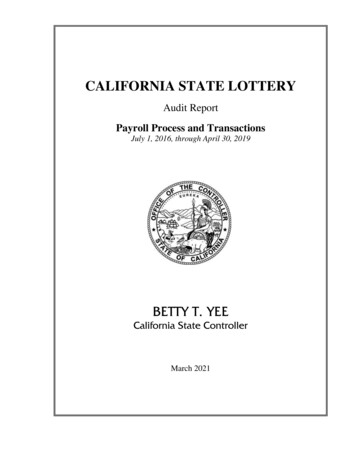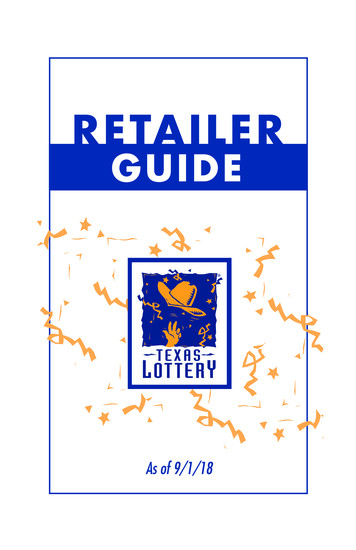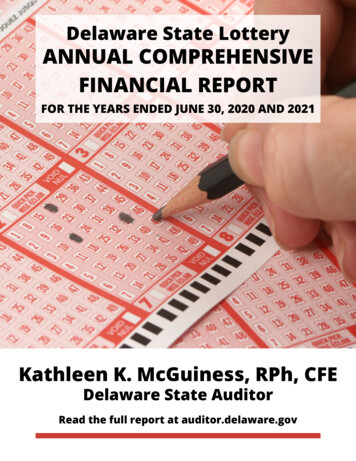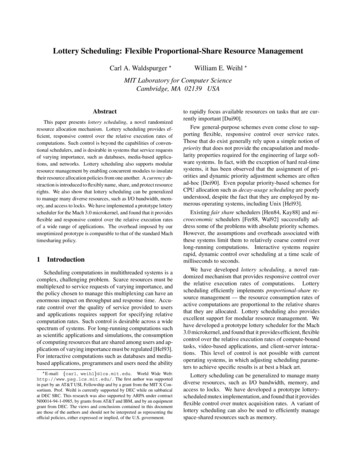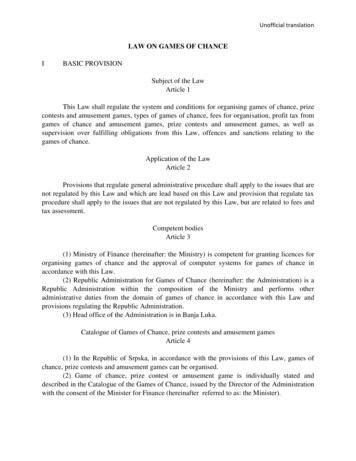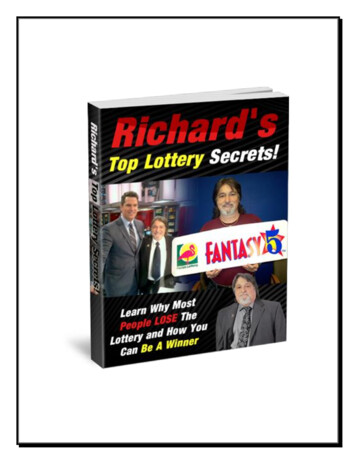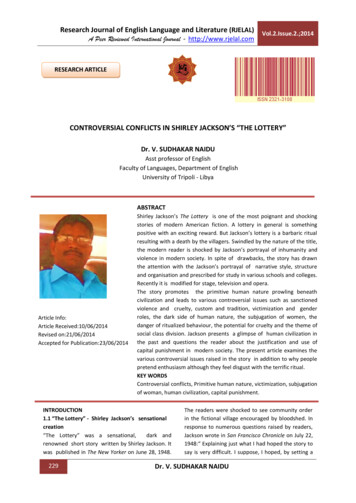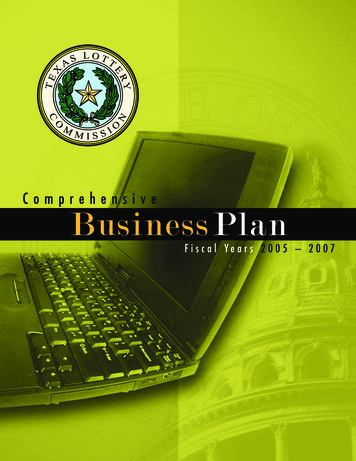
Transcription
ComprehensiveBusiness PlanFiscal Years 2005 – 2007
COMPREHENSIVE BUSINESS PLANFiscal Years 2005 – 2007ByTexas Lottery Commission
TEXAS LOTTERY COMMISSIONComprehensive Business PlanFiscal Years 2005 – 2007FOREWORDThis document, the Texas Lottery Commission Comprehensive Business Plan for fiscal years 2005 –2007, was prepared by the management of the agency, inclusive of all divisions within the agencyincluding, but not limited to, the Lottery Operations Division and the Charitable Bingo OperationsDivision. This report has been prepared as a result of and in accordance with recommendationscontained in the Sunset Advisory Commission Staff Report issued in August 2002 and restated inthe Sunset Advisory Commission Staff Report issued in April 2004 (detailed below).3.2 Require the agency to develop a comprehensive business plan.The Lottery Commission’s major initiatives should be guided by a comprehensive business plan to ensure their cost effectiveness. The business plan should include a specificdescription of each program, key management information, accurate financial data, and adetailed financial management plan. The Commission should review the business plan atleast annually to assess the overall performance and value of each project. Projects thatfail to meet financial objectives should be adjusted or terminated. This recommendationwill build on recent efforts by the agency and ensure that business planning continues inthe future.Throughout this document, the term “Texas Lottery Commission” (TLC) is used in reference to theentire agency. The terms “Lottery” and “Charitable Bingo” refer to the two very different and distinctfunctions of the agency and are mainly used where an element of this plan is only relevant to onefunction or the other. There are significant differences between Lottery and Charitable Bingo operations. Most importantly, the Lottery is charged with generating revenue for the State of Texas whileregulating those locations licensed to sell the Games of Texas, whereas Charitable Bingo is chargedwith licensing and regulating an industry that generates revenues for nonprofit organizations inTexas. This is an important distinction that statutorily limits Charitable Bingo from adopting strategies and action plans that would promote consumer participation in bingo playing.
TABLE OF CONTENTSI. Executive Summary .1II. Overview of the Texas Lottery Commission .41. History.42. Management and Organizational Structure.53. Vision, Mission and Core Values.6III. Market Analysis .71. General Environment.72. Markets and Demographics .83. Products.94. Competition .10IV. Financial Overview.101. Management View – Lottery Operations .102. Transparent View – Lottery Operations .113. Charitable Bingo.12V. Business Plan Framework .13VI. Objectives .14VII. Strategies and Action Plans.15
TEXAS LOTTERY COMMISSIONComprehensive Business PlanFiscal Years 2005 – 2007I. EXECUTIVE SUMMARYOne billion dollars. For a decade, the State of Texas has offered to its citizens fun, convenient, secureand legal gaming choices through the Texas Lottery while generating average annual contributions nearing one billion dollars to the Foundation School Fund. In an era where the subject of financing publiceducation is a key issue for the citizens of Texas, one billion dollars can have a profound impact.22.8 million.1 This was the attendance at licensed charitable bingo events in 2003, more than 2.5 timesthe combined attendance of Texas’ major league baseball, football, basketball and hockey teams.2 Whileenjoying the excitement and social aspects of the games, Texans contributed 29.7 million to Texas charities and 15.1 million to the State’s General Revenue Fund.3 In North America, only Ontario andIndiana enjoy the benefits of a larger charitable bingo industry than Texas.4The Texas Lottery Commission (TLC), as a state agency, strives to be a careful steward of the resources itis provided to carry out its mission. While Charitable Bingo Operations is appropriated like most otherstate agencies, the TLC must produce its own operating resources and deliver the expected annual revenue to the State. Combining the performance expectations of a for-profit business with the fiscalaccountability of a government agency presents unique challenges for agency management. Add to themix the dynamics of a gaming and entertainment industry with aggressive for-profit competition, prevalent illegal substitutes, emerging technological advances and a public constituency that is generallyunaware of the true beneficiaries of its operations, and one can begin to appreciate the difficult environment within which the TLC must operate to deliver the expected profits for the Foundation SchoolFund and the expected services for Texas charities.These unique challenges underscore the need for the TLC to venture beyond the State’s standard strategic planning process and develop a Comprehensive Business Plan with a three-year horizon. This writtenplan represents the tangible expression of process that involved the TLC’s management team and a teamof consultants led by Dr. Gary M. Cadenhead, a senior lecturer at the Red McCombs School of Businessat The University of Texas at Austin. It is designed to complement, not replicate or replace, other planning documents produced by TLC’s management.TLC Agency Strategic Plan: For Fiscal Years 2005 – 2009 Period, p. 39.Accordance to attendance figures published on http://sports.espn.go.com, the combined attendance for Texas' eight majorprofessional sports teams was 8.5 million in the 2003 and/or 2003 – 04 seasons.3TLC Agency Strategic Plan: For Fiscal Years 2005 – 2009 Period, p. 38.4Ibid., p. 36.121
Texas Lotter y CommissionThe development process for the business plan began with an overview of the TLC’s history, organizational structure, mission, vision and core values, followed by a high-level market analysis and financialreview. A “fresh look” yielded the perspective that virtually all key operating activities within the TLCcan be categorized within five areas:1. Compliance – activities that ensure that agency rules and laws established by the Legislature arefollowed;2. Trust – activities that safeguard the integrity of the games and ensure proper stewardship of resources;3. Contributions and Charitable Proceeds – activities that maximize the financial benefits to theFoundation School Fund and Texas charities that operate bingo games as fundraisers;4. Communications – activities that share information and promote understanding about the TLC’spurpose, operating activities and use of resources; and5. People – activities that enable the TLC to attract, retain, motivate and develop the quality humancapital upon which the State depends.With the framework established, the TLC’s management developed and articulated four objectives, eightstrategies and 23 action plans that will guide its resource allocation decisions and help it achieve a “preferredfuture” by 2007. The TLC will dedicate resources toward the goals established in the objectives, strategiesand action plans developed during the business planning process. The TLC will benchmark its performanceby evaluating the success of individual action plans in meeting stated objectives in the next three years.Objective #1 – Maintain a strong culture and image of compliance and trust.Strategy #1 – Implement policies andprocesses that identify and mitigate risk tothe TLC.Action Plan #1 – Develop business continuity planning for potentialbusiness-disrupting events.Action Plan #2 – Implement an internal vendor monitoring program toidentify potential financial or reputation risks for business disruption.Action Plan #3 – Assess cost/benefit of voluntarily adopting private-sector corporate governance best practices.Action Plan #4 – Develop an independent process for reviewing andreporting accusations of inappropriate activity.Strategy #2 – Implement a “transparentoperations” strategy.Action Plan #5 – Promote a “where the money goes” public awarenesscampaign.Action Plan #6 – Develop a Bingo Annual Report that shares operational information and data on Bingo’s impact on state charities.2
Comprehensive Business Plan 2005 – 2007Objective #2 – Grow contributions to Texas’ Foundation School Fund.Strategy #3 – Develop and enhance new andexisting products and technologies.Action Plan #7 – Study demographics, identify growth markets anddevelop new products that appeal to them.Action Plan #8 – Develop an “R&D Pipeline” analysis to align organization around new gaming innovations and technologies.Action Plan #9 – Evaluate utilizing informative marketing techniquesand studying multiple message-delivery media formats to more effectively share knowledge about the TLC and its games with playingand non-playing Texans.Action Plan #10 – Develop a business plan for a virtual “Lottery Store”that would sell Lottery-branded gifts and apparel.Strategy #4 – Develop and enhance new andexisting channels for marketing and deliveringTLC products and growing contributions.Action Plan #11 – Consider utilizing cross-promotional opportunitieswith quality brands and large retailers.Action Plan #12 – Utilize the deployment of emerging lottery producttechnologies to foster expansion strategies in new distribution channels.Action Plan #13 – Enhance retailer licensee recruitment efforts.Action Plan #14 – Enhance and expand communications processeswith licensees.Strategy #5 – Implement processes toenhance the efficiency of operations (including new uses of technology).Action Plan #15 – Study enterprise-process impact of new technologyinvestments, including staffing impact.Action Plan #16 – Develop a Contract Procedures Guide containingcontract “best practices,” “lease vs. buy” analyses for capital purchases, etc.Action Plan #17 – Revisit the structure of long-term contracts to assessand identify opportunities to enhance current services, reduce costsand/or better align financial interests of vendors with the TLC.Action Plan #18 – Implement “paperless” (e-records management)initiatives.Objective #3 – Plan responses to emerging environment.Strategy #6 - Improve in-house capabilities toidentify and assess emerging opportunitiesand threats to the TLC.Action Plan #19 – Develop a Resource Center to assess emergingopportunities and threats and accumulate research on gaming trendsand technologies that may aid the TLC’s management and State policymakers in evaluating the future of gaming in Texas.Objective #4 – Improve the quality, skill and satisfaction of TLC staff.Strategy #7 – Increase the efficiency andeffectiveness of the TLC through betterintra-organizational communications.Action Plan #20 – Develop an Intranet for sharing internal knowledgeand resources.Action Plan #21 – Implement process for encouraging, reviewing andrewarding employee-developed innovations.Action Plan #22 – Continually reassess the effectiveness of the TLC’sorganizational structure, outsourcing support functions where appropriate.Strategy #8 – Enhance professional development initiatives within the TLC.Action Plan #23 – Develop a mentoring program within the TLC.3
Texas Lotter y CommissionII. OVERVIEW OF THE TEXAS LOTTERY COMMISSIONThe Texas Lottery Commission (TLC) has two main functions:The TLC, under the authority granted the agency by the State Lottery Act, administers the Texas Lotterygames in an efficient and secure manner using appropriate marketing tools and innovative technology togenerate revenue for the State of Texas while enhancing public confidence in the integrity and fairness ofthe games.The Charitable Bingo Operations Division is charged under the Bingo Enabling Act with the regulationand administration of all charitable bingo-related activities in the State of Texas, and contributes to theregulatory and tax and revenue collection functions of the agency. The Division licenses all bingo-relatedactivities, collects taxes and prize fees generated from the conduct of charitable bingo, audits bingolicensees, conducts tests on bingo products intended for use in Texas, such as bingo paper, pull-tabs andelectronic equipment, and makes quarterly allocations to local units of government for their share of theprize fees collected.5Article III, Section 47, of the Texas Constitution, Chapter 467, Government Code, the State Lottery Actand the Bingo Enabling Act are the operative laws for the TLC. These laws set out the primary dutiesand powers of the TLC, which are to administer and appropriately market the Texas Lottery and to regulate charitable bingo in Texas.1. History6In November 1980, Texas voters approved a constitutional amendment authorizing charitable bingo on alocal option basis. The amendment required all bingo proceeds be spent in Texas for charitable purposes.The first bingo licenses were issued in the spring of 1982.In November 1991, Texas voters approved a constitutional amendment authorizing a state lottery. TheTexas Lottery began generating revenue for the State of Texas in 1992 as a division within theComptroller of Public Accounts.The TLC was formed as an independent agency on September 1, 1993. Regulatory authority forcharitable bingo was transferred to the Texas Lottery Commission effective April 1, 1994. The TexasState Legislature decided that profits from the Lottery would be dedicated specifically for education inthe State of Texas after September 1997.56TLC Agency Strategic Plan: For Fiscal Years 2005 – 2009, p. 6.Ibid., pp. 2, 50.4
Comprehensive Business Plan 2005 – 20072. Management and Organizational StructureThe three-member Texas Lottery Commission sets policy, promulgates rules for the agency, and performsall other duties required by law. The Governor appoints Commission members, with the advice and consent of the Senate, to staggered six-year terms. One member must have experience in the bingo industry.7The Executive Director, the Charitable Bingo Operations Director, and the Internal Audit Directorreport to the three-member Commission. The Executive Director is the focal point for decision-making and strategic planning for theadministration of the agency. The Executive Director is also the primary source of information tothe Texas Legislature, Governor’s Office, and other state governmental entities for agency- andLottery-related issues. The Charitable Bingo Operations Director is responsible for the day-to-day operations relating tothe regulation of charitable bingo, ensuring that the staff carries out applicable state law and TLCpolicies. The Charitable Bingo Operations Director is also the primary source of information tothe Texas Legislature, Governor’s Office, and other state governmental entities for charitablebingo-related issues. The Internal Audit Director serves as the in-house independent appraisal function, assistingmanagement and the three-member Commission in the effective discharge of their responsibilities.To this end, the Internal Audit Director is responsible for providing analyses, appraisals, recommendations, counsel, and information concerning the activities reviewed to improve the effectiveness of risk management, control, and governance processes.The agency is divided into 12 divisions: Executive, Charitable Bingo Operations, Internal Audit, LotteryOperations, Security, Information Technology, Financial Administration, Marketing, Legal, HumanResources, Media Relations and Governmental Affairs. Except for the Charitable Bingo Operations andInternal Audit directors, who report directly to the Commissioners, each division director reports to theDeputy Executive Director, whoreports to the Executive Director.TLC DivisionFTEs%FTE Analysis by DivisionAs of May 2004, the TLC had 325full-time equivalent (FTE) positionsallocated to 12 divisions:7Ibid., p. 12–13.ExecutiveCharitable Bingo OperationsInternal AuditLottery OperationsSecurityInformation TechnologyFinancial AdministrationMarketingLegalHuman ResourcesMedia RelationsGovernmental 21.2100.0
Texas Lotter y Commission3. Vision, Mission and Core ValuesVision – To be the preeminent Lottery and Charitable Bingo agency through innovative leadership.Lottery Mission – The Texas Lottery is committed to generating revenue for the State of Texas throughthe responsible management and sale of entertaining lottery products. The Texas Lottery will incorporatethe highest standards of security and integrity, set and achieve challenging goals, provide quality customer service and utilize a TEAM approach.Charitable Bingo Mission – Provide authorized organizations the opportunity to raise funds for theircharitable purposes by conducting bingo. Determine that all charitable bingo funds are used for a lawfulpurpose. Promote and maintain the integrity of the charitable bingo industry throughout Texas.Core ValuesIntegrity and The Commission works hard to maintain the public trust by protecting and ensuring theResponsibility security of our lottery games, systems, drawings and operational facilities. We value andrequire ethical behavior by our employees, licensees and vendors. We promote theintegrity of charitable bingo in Texas for the benefit of charitable organizations.InnovationWe strive to incorporate innovation into our products to provide the citizens of Texas withthe best entertainment experience available through our products. We pursue the use oftechnology that enhances the services that we provide to our customers and reduces ouroperating expenses.We emphasize fiscal accountability by ensuring that all expenditures directly or indirectlyFiscalAccountability generate revenue, enhance security, fulfill regulatory requirements, improve customerservice and/or boost productivity. We recognize our responsibility in generating revenue forthe State of Texas without unduly influencing players to participate in our games. Wemaximize benefits to charities through the continual examination and review of charitablebingo operations.The Commission takes pride in providing exemplary service to the people of Texas throughCustomerResponsiveness the courteous dissemination of clear and accurate information about our products,services and regulatory functions. We seek and respond to feedback expressed by ouremployees, retailers, licensees and the playing and non-playing public. We apply this feedback in the development of our products and in the services we provide.TeamworkWe are committed to creating an environment of mutual respect where open, honestcommunication is our cornerstone. We embrace the diversity of our team and individualperspectives in working together to achieve our common goals.ExcellenceWe strive for excellence by taking a position of leadership on issues that impact the TLCand achieve challenging goals by focusing on our core values.6
Comprehensive Business Plan 2005 – 2007III. MARKET ANALYSIS1. General EnvironmentState lotteries have progressed from nonexistent to pervasive in just 40 years since New Hampshirebecame the first state to enact a state-run lottery in 1964. Texas became the 35th state to legalize lotteryoperations in 1992.8 Today, nearly 40 states conduct lotteries. Charitable bingo and/or other charitablegaming activities are legal in 46 states and the District of Columbia.9Charitable bingo and Lottery products compete in a mature yet dynamic market for the discretionaryentertainment dollars of primarily Texans over 18 years of age. In order to maximize its contributions tothe Foundation School Fund, the Lottery must understand its market environment, population andcompetition and tailor its business strategies appropriately. Charitable Bingo supports the efforts of charitable organizations to raise funds for their charitable purposes and ensure the integrity of the industry.Additionally, taxes collected from the conduct of charitable bingo are remitted to the State’s GeneralRevenue Fund. The TLC strives to provide the citizens of Texas with the best entertainment experienceavailable through its products. Periodically, changes are recommended to keep the games innovative andexciting for Texas players.New and potential technologies, game innovations and legislative changes present a dynamic environment for the TLC and its industry in fiscal years 2005 – 07. The Lottery responded to legislative authorization to engage in multi-jurisdictional gaming by agreeing to join the Mega Millions game, which waslaunched in Texas in late 2003. Mega Millions is representative of opportunities that the TLC may betasked to manage for the benefit of the people of Texas. The Charitable Bingo Operations Divisionexpects that a new legislative change doubling the number of temporary bingo games that may be conducted by bingo operators will have a positive impact on bingo attendance and yield incremental valueto the charities for which they operate.10 Additional trends occurring in the gaming industry includeInternet gaming, video lottery terminals, Keno and linked bingo 0TLC Agency Strategic Plan: For Fiscal Years 2005 – 2009, p. 56.897
Texas Lotter y Commission2. Markets and Demographics11The Lottery and charitable bingo market population includes primarily Texans at least 18 years of age.Previous market studies for Lottery games show a diverse playing public that is generally representative ofthe State’s population.12 Ethnic, gender, education and household income demographics fail to identifydominant characteristics that would influence the TLC’s marketing strategy.Charitable bingo players tend to be Caucasian, married, female and over 65 years of age with a highschool education and annual incomes of less than 25,000. This dominant demographic highlights thecultural and social aspects of the games that align with older Texans. Attendance at licensed bingo gameswas approximately 22.8 million in 2003.13The following table presents highlights from the TLC’s most recent demographic studies:DemographicLotteryCharitable BingoHousehold IncomeTexans most likely to play haveannual incomes greater than 50,000; those least likely to playhave incomes less than 20,000.Texans most likely to play haveincomes of 10,000 to 24,999; thosewith incomes greater than 60,000play more frequently (3 times perweek).EducationAdults with some college education and college degrees represent67% of player population; Texanswith less than a high school education are the least likely to play(8%).Adults with a high school education(40%) are the most common, followedby those with some college experience(23%). College graduates are least likely to play.AgeMore than 45% of player basefalls within 36 to 55 years old;seniors (65 ) and young adults(18-25) are the least likely to participate, with 11% each.Seniors (65 ) are the most common;those under age 35 are least likely toplay.GenderSlightly skewed towards females.83% are female.EthnicityRelatively proportionate to State'spopulation.16% are African American, comparedto less than 10% for Lottery.TLC Agency Strategic Plan: For Fiscal Years 2005 – 2009, p. 56–61.Texas Lottery Marketing Plan Fiscal Year 2003: Five Year Plan 2003 – 2007, p. 3–5.13TLC Agency Strategic Plan: For Fiscal Years 2005 – 2009, p. 58.11128
Comprehensive Business Plan 2005 – 20073. ProductsThe TLC offers two categories of game styles to its players: (1) Instant products (Scratch Offs) consist ofgames that allow players to purchase tickets with a variety of themes, play-styles and price points. Instantgames offer players the immediate gratification of winning a prize; (2) “On-line” products are thosegames in which tickets are generated from a terminal connected to a central system, and a drawing isheld to determine a set of winning numbers. There are currently five on-line games offered.Instant Games – Instant games are played by scratching off a latex covering on each ticket to see if aprize has been won. A variety of themes, play styles and prize structures are available in a constantlyrevolving lineup of approximately 100 games. Players enjoy multiple chances and multiple ways to winon each ticket. The fiscal year 2005 sales goal for instant games is 2.6 billion.Lotto Texas – A twice-weekly on-line game that features a 5-of-44 plus 1-of-44 bonus-ball-style matrixin which players select five numbers between 1 and 44 plus the bonus ball number for a chance to win amulti-million dollar jackpot prize. When no ticket matches all six numbers drawn, the jackpot increasesfor the following draw. There are eight prize categories, and the odds of winning any prize are 1 in 57.The highest prize tiers are pari-mutuel, meaning that the prize pool is divided equally among all the winners in the respective prize level. The fiscal year 2005 sales goal for Lotto Texas is 440 million.Texas Two Step – A twice-weekly on-line 4-of-35 plus 1-of-35 bonus ball game. Players select fournumbers plus a bonus ball number for a chance to win a jackpot prize. Jackpots start at 200,000 andthere are seven different ways to win. The fiscal year 2005 sales goal for Texas Two Step is 40 million.Pick 3 – A twice-daily on-line game (12 drawings a week) with a top prize of 500 on a 1 wager.The fiscal year 2005 sales goal for Pick 3 is 290 million.Cash Five – A daily on-line game with a 5-of-37 lotto-style matrix. All prizes are pari-mutuel (exceptfor matching 2 of 5, which pays a guaranteed 2). If no ticket matches all five numbers drawn, the prizepool for the top 5-of-5 prize is allocated or rolls down to the 4-of-5 prize (i.e., does not carry forward).The fiscal year 2005 sales goal for Cash Five is 100 million.Mega Millions – A twice-weekly multistate on-line game that features a 5-of-52 plus 1-of-52 bonusball-style matrix in which players select five numbers between 1 and 52 plus the bonus ball number for achance to win a multi-million-dollar jackpot prize. The jackpot prize starts at 10 million. When noticket matches all six numbers drawn, the jackpot increases for the following draw. Eleven states participate and share operating costs, creating greater opportunities for giant jackpots. The fiscal year 2005 salesgoal for Mega Millions is 225 million. The Megaplier feature of the Mega Millions game allows players the opportunity to wager an extra 1 per playboard for a chance to increase their non-grand/jackpotprize winnings by 2, 3 or 4 times depending upon the Megaplier number drawn. The fiscal year 2005sales goal for Megaplier is 55 million.The Marketing Division works with the Lottery Operator (GTECH) and instant ticket vendors to continuously analyze the product mix and game rules for its on-line and instant games. In particular, instantgames are turned over quickly to optimize retailer inventory management. Approximately 100 instantgames are introduced each year with an average sell-through of 12 weeks.9
Texas Lotter y Commission4. CompetitionAs a state agency operated for the benefit of the people of Texas, the TLC does not face direct competition for on-line or instant games within its jurisdictional boundaries. However, there are few limits to thecompetition for consumer entertainment dollars. Lottery and charitable bingo products are not requiredpurchases for consumers. When they choose to play, the primary motivation is entertainment; however,there are numerous entertainment substitutes available, including a growing number of gaming alternatives.Legal Gaming Alternatives – Horse racing and casinos are the primary legal alternatives for Texans overthe age of 18. Racing is a mature industry that has felt aggressive competition from casinos and racetracks equipped with video lottery terminals (VLTs) in neighboring states such as Oklahoma, NewMexico and Louisiana.14Illegal Gaming Alternatives – The greatest direct competition to the TLC’s Lottery games may comefrom the proliferation of illegal gambling devices as defined by Chapter 47, Texas Penal Code.Non-jurisdictional Gaming Alternatives – The Internet poses similar challenges to the Lottery’s businessmodel. Web sites and e-commerce applications enable consumers to play games over the
Action Plan #10- Develop a business plan for a virtual "Lottery Store" that would sell Lottery-branded gifts and apparel. Action Plan #11 - Consider utilizing cross-promotional opportunities with quality brands and large retailers. Action Plan #12 - Utilize the deployment of emerging lottery product
